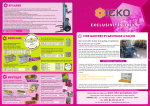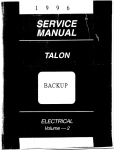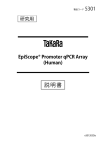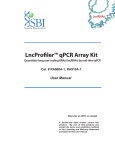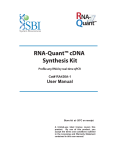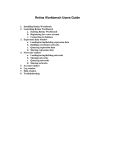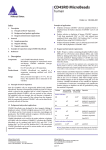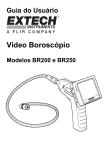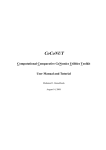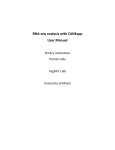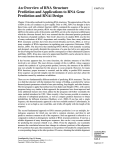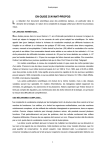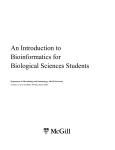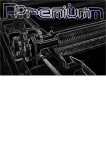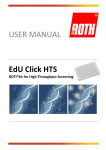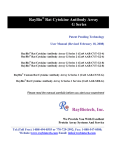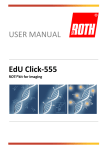Download Disease-related human lncRNA profiler User Manual
Transcript
Disease-Related Human LncRNA Profiler Cat. #RA920A, B, C, D-1 User Manual Store at -20ºC ver. 1-100611 A limited-use label license covers this product. By use of this product, you accept the terms and conditions outlined in the Licensing and Warranty Statement contained in this user manual. Disease-related human lncRNA Profiler Cat. #RA920A-D-1 Table of Contents I. Introduction and Background..................................................2 A. Overview .........................................................................2 B. Long noncoding RNAs and diseases................................2 C. Overview of the Entire Protocol .....................................5 D. Additional Required Materials ........................................7 II. Protocol ...................................................................................8 III. IV. A. B. C. D. RNA preparation and quality control ..............................8 First Strand cDNA Synthesis ............................................9 Real-time qPCR Reaction Setup ......................................9 Data Analysis: ∆∆Ct Method.........................................12 Quality Control and Sample Data .....................................14 A. B. Validation Tests..............................................................14 Sample Data ...................................................................19 Troubleshooting ................................................................20 V. References ........................................................................21 VI. Technical Support .............................................................23 VII. Licensing and Warranty Statement ..................................24 888-266-5066 (Toll Free) 650-968-2200 (outside US) Page 1 System Biosciences (SBI) I. User Manual Introduction and Background A. Overview Long noncoding RNAs (lncRNAs), as a new class of transcripts, have been recently revealed to be pervasively transcribed in the genomes of human and mouse. Multiple lines of evidence increasingly link lncRNAs to diverse human diseases. Diseaserelated human lncRNA profiler qPCR array allows for the quantification of differential expression of 83 individual lncRNAs among various experimental RNA samples. All 83 lncRNAs chosen for the array are based on publications and they are implicated in diseases ranging from neurodegeneration to cancer. The array plate also includes the house keeping genes and small RNA transcripts for normalization purposes. Using real-time RTPCR, you can easily and reliably analyze expression of a panel of lncRNAs that have potential roles in a variety of cellular processes such as cell cycle progression, differentiation, self-renewal and apoptosis. Disease-related human lncRNA profiler is easy, convenient, sensitive and specific. It is suitable for cDNA synthesized by either random primer, oligo dT primer, or strand specific primer. It can be used for research in cancer, stem cells, immunology, biomarker discovery & validation, as well as phenotypic analysis of cells. To ensure optimal results, please read the entire manual before using the materials supplied with this kit. B. Long noncoding RNAs and diseases A distinctive feature of eukaryotic genomes is the abundance of noncoding RNA (ncRNAs). In addition to small regulatory RNAs, such as microRNAs, genomic projects over the past decade have revealed the existence of long noncodingRNAs (lncRNAs) —those more than 200 bp in length — including large intergenic ncRNA (lincRNA) and antisense ncRNAs. Like microRNAs, the expression Page 2 ver. 1-100611 www.systembio.com Disease-related human lncRNA Profiler Cat. #RA920A-D-1 of many identified lncRNAs shows spatial- and temporal-specific patterns. Recent studies also demonstrate that LncRNAs participate in a diverse range of biological processes from cell cycle control to cell differentiation through distinct mechanisms at the transcriptional, post-transcriptional and epigenetic level. Almost every step in the life cycle of genes can be influenced by lncRNAs. The involvement of lncRNAs in human diseases provides a great opportunity for biomedical research and their clinical implications could be far more prevalent than we previously imagined. Like protein coding genes, lncRNAs can serve as oncogenic and tumor-suppressor genes. The story of HOTAIR illustrates nicely how the relationship between epigenetic regulation by lncRNA and cancer. HOTAIR was first identified as a 2.2kb lncRNA in the HOXC locus, which represses transcription in trans of HOXD genes by John Rinn, et al. This repressive action is mediated by the interaction of HOTAIR with the Polycomb Repressive Complex 2 (PRC2). Later study from John’s group further found that HOTAIR is dramatically overexpressed in breast tumors and the expression of HOTAIR in primary breast tumors is a powerful prognosis marker of patient outcomes such as metastasis and death. Enforced expression of HOTAIR causes altered H3K27 methylation pattern and increased invasiveness. In contrast, the depletion of HOTAIR results in the opposite cellular phenotype. These studies demonstrate how lncRNA manipulate the epigenetic machinery to remold the epigenetic landscape leading to cancer. Recent genome-wide studies have revealed that numerous protein-coding mRNAs have natural antisense transcript partners, most of which seem be noncoding RNA. Despite the lincRNAs such as HOTAIR, dysregulation of antisense ncRNAs could also lead to cellular transformation. Antisense ncRNA ANRIL is one of the examples. ANRIL is transcribed as antisense to the INK4n/ARF/INK4a promoter and overlaps with two exons of p15/CDKN2B. It controls expression in the INK4A/ARF locus 888-266-5066 (Toll Free) 650-968-2200 (outside US) Page 3 System Biosciences (SBI) User Manual which comprises the tumor-suppressor genes INK4n/ARF/INK4a, p16/CDKN2A and p15/CDKN2B. As demonstrated by Yap K. et al ANRIL interacts with CBX7, resulting in the targeting of the polycomb repressive complex 1 (PRC1) to the chromatin and establishing repressive epigenetic mark. Studies from Yu W et al and Kotake Y, et al have also shown that overexpression of ANRIL in prostate cancer results in the silencing of INK4n/ARF/INK4a and p15/CDKN2B by heterochromatin formation. Different from oncogenic lncRNAs (such as HOTAIR, ANRIL, and MALAT1), lncRNA GAS5 (growth arrest-specific 5) represents an example as a tumor suppressor. Studies from Coccia EM and Mourtada-Maarabouni M group have shown that GAS5 can be induced under starvation conditions and is abundant is abundant in cells whose growth has been arrested. In addition, GAS5 has also been observed to be downregulated in breast cancer. Kino T, et al revealed that Gas5 bound to the DNA-binding domain of the glucocorticoid receptor (GR) by acting as a decoy glucocorticoid response element (GRE), thus competing with DNA GREs for binding to the GR. Function as a "riborepressor" of the GR, GAS5 influences cell survival and metabolic activities during starvation by modulating the transcriptional activity of the GR. In addition to cancer, lncRNAs have also been shown involved in other disease such as Alzheimer’s Disease (AD). A study from Faghihi MA, et al nicely demonstrated how lncRNA BACE1-AS involves in the pathogenesis of AD. β-secretase-1 (BACE1) is a crucial enzyme in AD pathophysiology, which has elevated level in subjects with AD compared with normal controls. As a natural antisense transcript, BACE1AS rapidly and reversibly upregulates BACE1 levels in response to a variety of stresses, acting as a post-transcriptional regulator. Consistent with BACE1 expression, BACE1AS expression were found increased in subjects with AD as well as in amyloid precursor protein transgenic mice. In summary, it has been shown that dysregulation of lncRNAs contributes to numerous diseases, highligting their potential use as biomarkers and therapeutic targets in the future. However, there Page 4 ver. 1-100611 www.systembio.com Disease-related human lncRNA Profiler Cat. #RA920A-D-1 are still many missing dots in our current understanding of lncRNA function. Future studies are needed to elucidate the mechanism by which lncRNAs are dysregulated, thereby contributing to the pathogenesis of disease. Disease-related human lncRNA Profiler is your first step toward the understanding of the role of lncRNAs in human diseases. C. Overview of the Entire Protocol Isolate RNA from your experimental samples (1ug RNA is recommended, treat with DNase) Convert Total RNA to cDNA cDNA1 cDNA2 Add cDNA to qPCR master mix Aliquot mixture across PCR array (Array profiles the expression of 83 disease-related lncRNA plus controls.) Perform real-time PCR (Collect real-time PCR data using your instrument’s software.) Profiler 1 Profiler 2 Analyze Changes in lncRNA expression (Straightforward analysis. Simply cut and paste the Ct value collected by your real-time instrument into an analysis spreadsheet. Fold change lncRNA expression between your samples are automatically calculated.) ∆Ct Value 20 Sample A Sample B 15 10 5 A3 A8 A9 A11 A12 B1 B4 B9 B10 B11 C2 C3 C4 C5 C6 C8 C9 C11 C12 D3 D7 E1 E3 E8 E12 F8 F11 F12 G4 0 888-266-5066 (Toll Free) 650-968-2200 (outside US) Page 5 System Biosciences (SBI) User Manual List of Components The Disease-related human lncRNA Profiler is available in 3 different plate formats, each tailored to a specific subset of realtime PCR instruments. Cat # For Real-time Instruments Plate Array # Plate # RA920A-1 ABI: 7000, 7300, 7500, 7900HT 96-well 2 2 RA920B-1 ABI: 7500 Fast , 7900HT Fast, StepOnePlus 96-well 2 2 RA920C-1 Bio-Rad: Opticon/Opticon2, Chromo-4, iCycler, MyiQ, iQ5, CFX96 Eppendorf: MasterCycler ep RelPlex 96-well 2 2 RA920D-1 Any Real-Time Instruments 96-well 20 1 All 83 lncRNAs chosen for the array are based on publications and they are implicated in diseases ranging from neurodegeneration to cancer. The array plate also includes the housekeeping genes and small RNA transcripts (which belongs to small nuclear RNA, small cytoplasmic RNA, and small cajal body-specific RNA) for normalization purpose. The Genomic DNA Control (GDC) in each PCR Array specifically tests for genomic DNA contamination in each sample during each run. 1 2 3 4 5 A 21A AAA1 aHIF AK023948 ANRIL B CCND1 ANCR CMPD DD3 DGCR5 DISC2 C HAR1B HOTAIR HOTAIRM1 HOTTIP HOXA1AS AA489505 D KRASP1 L1PA16 LIT LOC285194 LUST LincRNAVLDLR LincRNASFMBT2 MALAT1 E NDM29 PANDA PAR5 PCAT-1 PCAT-14 PCAT-29 PCAT-32 F PTENP1 RMRP ROR SAF SCA8 Sox2OT TUG1 UCA1 WT1-AS Y1 ACTB B2M G TMEVPG1 TU_001762 9 H 7SL scRNA 5.8S rRNA U87 scaRNA U6 smRNA small RNA transcripts 6 7 8 9 10 11 12 BC017743 BC043430 BC200 BCMS BIC GAS5 GOMAFU H19 H19-AS HAR1A HULC IPW IGF2AS MEG3 MER11C NEAT1 NCRMS PCAT-43 PCGEM1 PR-AT2 PRINS PSF inhibiting RNA SRA ST7OT1 ST7OT2 ST7OT3 ST7OT4 Telomerase RNA Y3 Y4 Y5 ZEB2NAT 7SK Negative control PGK1 GAPDH HPRT1 RPL1A RPL13A GDC anti-NOS2A BACE1AS DLG2AS EGO HOXA3AS HOXA3AS HOXA6AS HOXA11AS BI823151 BE873349 AK092154 housekeeping genes Internal Controls Page 6 ver. 1-100611 www.systembio.com Disease-related human lncRNA Profiler Cat. #RA920A-D-1 Shipping Conditions: The Disease-related human lncRNA Profilers are shipped at Room Temperature or Blue Ice. Storage Conditions: Keep plates at -20°C for long-term storage. When stored at -20°C, their quality is guaranteed for 12 months. The primers for the specific lncRNAs are provided desiccated in the wells of the optical qPCR plates. D. Additional Required Materials • • • • • • • • RNA Isolation Nuclease-free H2O Reverse-transcription Kit SYBR Green qPCR Master Mix Real-time qPCR Instrument Instrument-specific optical qPCR plates if you choose RA920D-1 Calibrated Multi-Channel Pipettor RNase/DNase-free pipette tips and tubes 888-266-5066 (Toll Free) 650-968-2200 (outside US) Page 7 System Biosciences (SBI) II. User Manual Protocol Please read through this entire protocol before beginning your experiment. Prepare a workspace free of DNA contamination. Wear gloves and maintain an RNase-free work area while performing this protocol. A. RNA preparation and quality control High quality RNA is essential for obtaining good real-time PCR results. RNA samples must meet the standards of integrity and purity from protein, organics, and genomic DNA contamination. For best results from the PCR Array, all RNA samples should demonstrate consistent quality. You can measure your RNA concentration and purity by UV spectrophotometry. You can also check ribosomal RNA band integrity by electrophoresis or by using an Agilent BioAnalyzer. • • • A260:A230 ratio should be greater than 1.7. A260:A280 ratio should be between 1.8 and 2.0. The total RNA concentration by A260 should be greater than 40 µg /ml. Eliminating genomic DNA contamination is essential for obtaining optimal real-time gene expression profiling. The problem associated with genomic DNA contamination is particularly acute for genes with low expression levels. Even a few copies of genomic DNA contamination can significantly alter the interpretation of qRT-PCR results for low copy mRNA. Due to the presence of pseudogenes, even cross-intron primers are not a reliable method for avoiding amplification resulting from contaminating genomic DNA. The Genomic DNA Control (GDC) in this PCR Array specifically tests for genomic DNA contamination in each sample during each run. Researchers can easily detect potential genomic DNA contamination using the representative Ct value for the GDC well on the PCR Array. A GDC threshold cycle value less than 35 indicates the presence of a detectable amount of genomic DNA contamination that is recommended to be addressed. Page 8 ver. 1-100611 www.systembio.com Disease-related human lncRNA Profiler Cat. #RA920A-D-1 Greater amounts of input total RNA yield a greater number of positive results. Lower amounts of input total RNA yield a smaller number of positive results and increase false negative results. B. First Strand cDNA Synthesis Use the same amount of total RNA in this reaction for every sample. We recommend that first time users start with 1.0-2.0 µg of total RNA for 96-well plate format. Please follow the protocol of the cDNA synthesis provided by the manufacturer. Dilute the resulting cDNA in 100µl with nuclease-free H2O. For in-house testing, ProtoScript® M-MuLV Taq RT-PCR Kit (NEB, Cat# E6400S) was used for cDNA synthesis with Random Primer Mix. Random Primer Mix is a optimized mixture of hexamers and Oligo d(T)23VN primer, which provides even and consistent coverage of the RNA template population across a wide range of RNA template concentration. Based on your experiments design, you can choose either Oligo dT primer, random primer mix, or strand specific primer to synthesis your cDNA. C. Real-time qPCR Reaction Setup 1. Mastermix qPCR Reaction Setup for a 96-well qPCR plate a. Briefly spin down all reagents b. Mix the following components in a 5-ml tube or reservoir 2X SYBR Green qPCR Mastermix buffer 1.1 ml cDNA 100 µl Nuclease-free water 1.0 ml Total 2.2 ml 888-266-5066 (Toll Free) 650-968-2200 (outside US) Page 9 System Biosciences (SBI) User Manual c. Load the Disease-related human lncRNA Profiler • Carefully remove the profiler array from its sealed bag • Add 20µl of cocktail to each well (except well H12, the GDC) in array plate from a reservoir with an eight-channel pipette. • Add 1µl NRT (no RT) sample or 1µl RNA sample, 10µl 2X SYBR Green qPCR Mastermix buffer, 9µl Nuclease-free water into well H12 to detect genomic DNA contamination. Note: This recipe provides an excess volume of ~ 200 µl for the 96-well format to allow for multiple pipetting. Note: Change pipet tips following each addition to avoid any cross-contamination between the wells or reactions. Note: Maxima® SYBR Green/Rox qPCR Master Mix (2x) was used for in-house testing (Thermo Scientific, Cat# K0222) Note: In the presence of genomic DNA, a PCR product of GDC in size of 184 bp is obtained. M 400bp 300bp 200bp 100bp Page 10 A B A: RNA sample with genomic DNA contamination B: RNA sample free of genomic DNA ver. 1-100611 www.systembio.com Disease-related human lncRNA Profiler Cat. #RA920A-D-1 For Customers who choose RA920D-1 a. Resuspend primers in primer plate with 20 µl nuclease-free water per well before use. (The primers are desicated in the primer plate.) b. Cocktail preparation in a reservoir 2X SYBR Green qPCR Mastermix buffer 1.1ml cDNA 100 µl Nuclease-free water 890 µl Total 2.090 ml c. Using an eight-channel pipette, add 19 µl of cocktail to each well (except well H12, the GDC) in qPCR plate which matches your qPCR instrumentation. d. Add 1µl NRT (no RT) sample or 1µl RNA sample, 10µl 2X SYBR Green qPCR Mastermix buffer, 8µl Nuclease-free water into well H12 to detect genomic DNA contamination. e. Load 1 µl per well of each of the primers from the primer plate into your qPCR plate. Once reagents are loaded into the wells, cover the plate with an optical adhesive seal and spin briefly in a centrifuge to bring contents to bottom of wells. Place plate in the correct orientation (well A1, upper left) into the Real-time qPCR instrument and perform analysis run. 888-266-5066 (Toll Free) 650-968-2200 (outside US) Page 11 System Biosciences (SBI) User Manual 2. Real-time qPCR Instrument Parameters Follow the guidelines as detailed for your specific Real-time instrumentation. The following parameters tested by SBI were performed on an Applied Biosystems 7900 Real-time PCR System but can also apply to an ABI 7500 or 7300 system. Instrument Setup: qPCR cycling program 1. 2. 3. 4. 50°C 2 min. 95°C 10 min. 95°C 15 sec. 60°C 1 min. 40 cycles of steps 3 and 4 An additional recommendation is to include a melt analysis after the qPCR run to assess the Tm of the PCR amplicon to verify the specificity of the amplification reaction. Refer to the User Manual for your specific instrument to conduct the melt analysis and the data analyses of the amplification plots and Cycle Threshold (Ct) calculations. In general, Cycle Thresholds should be set within the exponential phase of the amplification plots with software automatic baseline settings. D. Data Analysis: ∆∆Ct Method Access our free Disease-related human lncRNA Profiler data analysis web portal from the following address: http://www.systembio.com/lncrna-research/long-non-codingrna/literature 1. Change all Ct values reported as greater than 35 or as N/A (not detected) to 35. At this point, any Ct value equal to 35 is considered a negative result. Page 12 ver. 1-100611 www.systembio.com Disease-related human lncRNA Profiler Cat. #RA920A-D-1 2. Examine the Threshold Cycle values of the Genomic DNA Control wells. If the value is greater than 35, then the level of genomic DNA contamination is too low to affect gene expression profiling results. No action is needed. If the value is less than 35, then genomic DNA contamination is evident. 3. Calculate the ∆Ct for each lncRNA in the plate. ∆Ct = CtlncRNA–CtAVG Internal Control 4. Calculate the ∆∆Ct for each lncRNA across two PCR Arrays ∆∆Ct = ∆Ct (sample) - ∆Ct (control) 5. Calculate the fold-change for each gene from the control to -∆∆Ct . the sample as 2 888-266-5066 (Toll Free) 650-968-2200 (outside US) Page 13 System Biosciences (SBI) III. User Manual Quality Control and Sample Data A. Disease-related Validation Tests human lncRNA Profiler 1. Real-time qPCR Validation The Disease-related human lncRNA Profiler plate was tested using a cohort of 9 cell line samples (293T, HT1080, hES, HDF, HFF, MCF7, MCF10A, MDA-MB-231, mesenchymal stem cells) converted to cDNA using the ProtoScript® M-MuLV Taq RT-PCR Kit. The resulting cDNA was tested according to aforementioned protocol. Shown below are the results of Real-time amplification plot for the entire plate for selected cell lines. Page 14 ver. 1-100611 www.systembio.com Disease-related human lncRNA Profiler Cat. #RA920A-D-1 2. End-point PCR Validation The Disease-Related human lncRNA Profiler plate was tested using a cohort of 9 cell line samples converted to cDNA using the ProtoScript® M-MuLV Taq RT-PCR Kit. 1µg of RNA was used to synthesize first strand cDNA with Random Primer Mix. The resulting cDNA was tested according to the protocol. Shown below are the end products for the entire plate selected from hES cell, 293T and HT1080 cells, and separated on a 1.5% agarose gel and stained with ethidium bromide. A 400bp B 400bp C 300bp D 400bp E 400bp F 400bp G 400bp H 400bp M 1 2 3 4 5 6 7 8 9 10 11 12 100bp 100bp 100bp 100bp 100bp 100bp 100bp 100bp 888-266-5066 (Toll Free) 650-968-2200 (outside US) Page 15 System Biosciences (SBI) User Manual 3. Sensitivity Tests The cDNAs were synthesized using decreasing amounts of total starting RNA input from human ES cells. Ct values were determined using the software automatic baseline and Ct settings. NEAT1 35 30 30 25 25 Ct Value Ct Value ROR 35 20 15 10 5 20 15 10 5 0 0 1000ng 500ng 100ng 50ng 1000ng Input RNA 100ng 50ng Input RNA 21A GOMAFU 35 35 30 30 25 25 Ct Value Ct Value 500ng 20 15 10 5 20 15 10 5 0 0 1000ng 500ng 100ng 50ng 1000ng Input RNA Page 16 500ng 100ng 50ng Input RNA ver. 1-100611 www.systembio.com Disease-related human lncRNA Profiler Cat. #RA920A-D-1 4. Reproducibility Tests Two sets of raw Ct data were obtained by two different scientists (A&B) at two different times using two different cell lines on Disease-related human lncRNA Profiler and are directly compared. The results demonstrate a high degree of correlation 2 (R >0.98). HT1080 40 R² = 0.9891 35 Scientist A 30 25 20 15 10 5 0 0 5 10 15 20 25 30 35 40 Scientist B 293T 40 R² = 0.9957 35 Scientist A 30 25 20 15 10 5 0 0 5 10 15 20 25 30 35 40 Scientist B 888-266-5066 (Toll Free) 650-968-2200 (outside US) Page 17 System Biosciences (SBI) User Manual 5. Specificity Tests A single lncRNA-specific product for each primer set was amplified by disease-related human lncRNA profiler. 21A AAA1 aHIF AK023948 ANRIL Anti-NOS2A BACE1 BC017743 BC043430 BC200 BCMS BIC 21A AAA1 aHIF 400bp 300bp 200bp 100bp Page 18 AK023 Anti- BACE1 BC017 BC043 ANRIL BC200 BCMS 948 NOS2A AS 743 430 ver. 1-100611 BIC www.systembio.com Disease-related human lncRNA Profiler Cat. #RA920A-D-1 B. Sample Data: analysis of disease-related human lncRNA expression levels in different cell lines using Real-time qPCR The cDNAs were synthesized from both 293T and HT1080 cells. The signals were normalized to expression levels of housekeeping genes and small RNA transcripts. ∆Ct increase and decrease in 293T vs. HT1080 cells are graphed. ∆Ct Value 20 HT1080 293T 15 10 5 A3 A8 A9 A11 A12 B1 B4 B9 B10 B11 C2 C3 C4 C5 C6 C8 C9 C11 C12 D3 D7 E1 E3 E8 E12 F8 F11 F12 G4 0 888-266-5066 (Toll Free) 650-968-2200 (outside US) Page 19 System Biosciences (SBI) IV. User Manual Troubleshooting Problem Too much background qPCR signals No qPCR signals Possible Solution in Use much less cDNA in the SYBR Green Mastermix. 1. Did you select SYBR Green as the Detector’s Reporter Dye? 2. Did the internal control work? 3. Use more cDNA in Mastermix. 4. Check Mastermix contents and try a subset with internal control as a positive control. 5. Also try lowering the Annealing Temperature to 50ºC. How do I select the Threshold Typically, place the threshold setting level for Ct analysis? in the upper third of the exponential phase of the amplification curve. Also, see the User Manual for your specific instrument or contact their technical support team for guidance. Page 20 ver. 1-100611 www.systembio.com Disease-related human lncRNA Profiler V. Cat. #RA920A-D-1 References 1. lncRNAdb: a reference database for long noncoding RNAs. Amaral PP, et al. Nucleic Acids Res. 2011 Jan;39 (Database issue):D146-51. Epub 2010 Nov 25. 2. Long noncoding RNAs and human disease. Wapinski O, Chang HY. Trends Cell Biol. 2011 Jun;21(6):354-61. Epub 2011 May 6. 3. A long noncoding RNA maintains active chromatin to coordinate homeotic gene expression. Wang KC, et al. Nature. 2011 Apr 7;472 (7341):120-4. Epub 2011 Mar 20. 4. Long non-coding RNA HOTAIR reprograms chromatin state to promote cancer metastasis. Gupta RA, et al.Nature. 2010 Apr 15;464 (7291):1071-6. 5. Molecular interplay of the noncoding RNA ANRIL and methylated histone H3 lysine 27 by polycomb CBX7 in transcriptional silencing of INK4a. Yap, KL, et al. Mol Cell. 2010 Jun 11:38(5):662-674. 6. Long non-coding RNA ANRIL is required for the PRC2 recruitment to and silencing of p15(INK4B) tumor suppressor gene. Kotake Y, et al. Oncogene. 2011 Apr 21;30(16):195662. Epub 2010 Dec 13. 7. Epigenetic silencing of tumour suppressor gene p15 by its antisense RNA. Yu, W, et al. Nature. 2008 Jan 10;451(7175):202–206. 8. MALAT-1, a novel noncoding RNA, and thymosin beta4 predict metastasis and survival in early-stage non-small cell lung cancer. Ji P, et al. Oncogene. 2003 Sep 11;22 (39):803141. 9. Regulation and expression of a growth arrest-specific gene (gas5) during growth, differentiation, and development. Coccia EM, et al. Mol Cell Biol. 1992 Aug;12(8):3514-21. 10. GAS5, a non-protein-coding RNA, controls apoptosis and is downregulated in breast cancer. Mourtada-Maarabouni M, et al. Oncogene. 2009 Jan 15;28(2):195-208. 888-266-5066 (Toll Free) 650-968-2200 (outside US) Page 21 System Biosciences (SBI) User Manual 11. Noncoding RNA gas5 is a growth arrest- and starvationassociated repressor of the glucocorticoid receptor. Kino T, et al. Sci Signal. 2010 Feb2;3(107):ra8. 12. Large intergenic non-coding RNA-RoR modulates reprogramming of human induced pluripotent stem cells. Loewer S, et al. Nat Genet. 2010 Dec;42 (12):1113-7. Epub 2010 Nov 7. Erratum in: Nat Genet. 2010 Dec;42 (12): 3 p following 1117. 13. Expression of a noncoding RNA is elevated in Alzheimer's disease and drives rapid feed-forward regulation of betasecretase. Faghihi MA, et al. Nat Med. 2008 Jul;14(7):723-30. Epub 2008 Jun 29. 14. lincRNAs act in the circuitry controlling pluripotency and differentiation. Guttman M, et al. Nature. 2011 Aug 28;477(7364):295-300. doi: 10.1038/nature10398. 15. Chromatin signature reveals over a thousand highly conserved large non-coding RNAs in mammals. Guttman M, et al. Nature. 2009 Mar 12;458(7235):223-7. 16. Evolution and functions of long noncoding RNAs. Ponting CP, Oliver PL, Reik W. Cell. 2009 Feb 20;136(4):629-41. 17. Application of housekeeping npcRNAs for quantitative expression analysis of human transcriptome by real-time PCR. Galiveti CR, et al. RNA. 2010 Feb;16(2):450-61. Epub 2009 Dec 29. 18. Diagnostic and prognostic signatures from the small noncoding RNA transcriptome in prostate cancer. MartensUzunova ES, et al. Oncogene. 2011 Jul 18. doi: 10.1038/onc.2011.304. [Epub ahead of print] 19. Extensive and coordinated transcription of noncoding RNAs within cell-cycle promoters. Hung T, et al. Nat Genet. 2011 Jun 5;43(7):621-9. doi: 10.1038/ng.848. Page 22 ver. 1-100611 www.systembio.com Disease-related human lncRNA Profiler VI. Cat. #RA920A-D-1 Technical Support For more information about SBI products and to download manuals in PDF format, please visit our web site: http://www.systembio.com For additional information or technical assistance, please call or email us at: System Biosciences (SBI) 265 North Whisman Road Mountain View, CA 94043 Phone: (650) 968-2200 (888) 266-5066 (Toll Free) Fax: (650) 968-2277 E-mail: tech@systembio.com General Information: info@systembio.com Technical Support: tech@systembio.com Ordering Information: orders@systembio.com 888-266-5066 (Toll Free) 650-968-2200 (outside US) Page 23 System Biosciences (SBI) VII. User Manual Licensing and Warranty Statement Limited Use License Use of the Disease-related human lncRNA Profiler™ (i.e., the “Product”) is subject to the following terms and conditions. If the terms and conditions are not acceptable, return all components of the Product to System Biosciences (SBI) within 7 calendar days. Purchase and use of any part of the Product constitutes acceptance of the above terms. Purchase of the product does not grant any rights or license for use other than those explicitly listed in this Licensing and Warranty Statement. Use of the Product for any use other than described expressly herein may be covered by patents or subject to rights other than those mentioned. SBI disclaims any and all responsibility for injury or damage which may be caused by the failure of the buyer or any other person to use the Product in accordance with the terms and conditions outlined herein. SBI has pending patent applications related to the Product. For information concerning licenses for commercial use, contact SBI. Limited Warranty SBI’s liability is expressly limited to replacement of Product or a refund limited to the actual purchase price. SBI’s liability does not extend to any damages arising from use or improper use of the Product, or losses associated with the use of additional materials or reagents. This limited warranty is the sole and exclusive warranty. SBI does not provide any other warranties of any kind, expressed or implied, including the merchantability or fitness of the Product for a particular purpose. SBI is committed to providing our customers with high-quality products. If you should have any questions or concerns about any SBI products, please contact us at (888) 266-5066. © 2011 System Biosciences (SBI). Page 24 ver. 1-100611 www.systembio.com

























